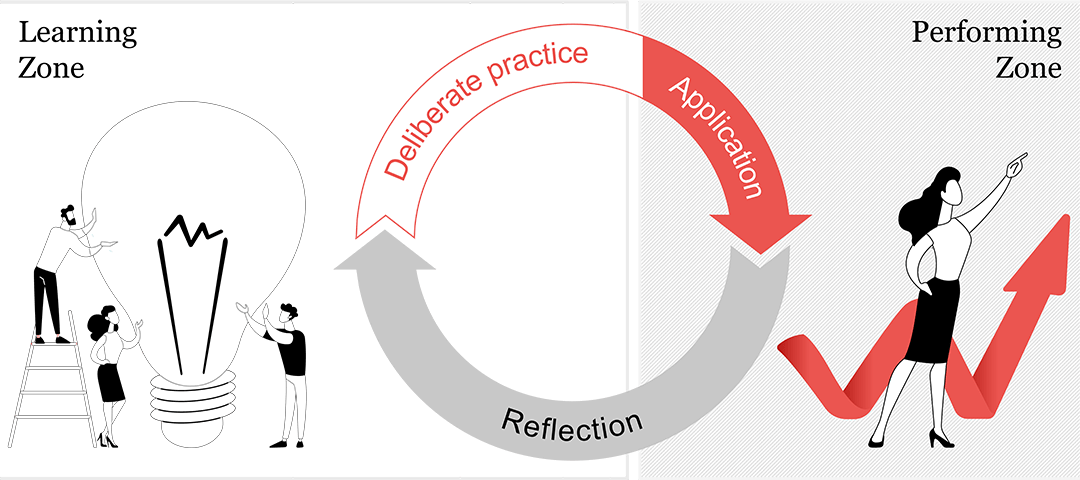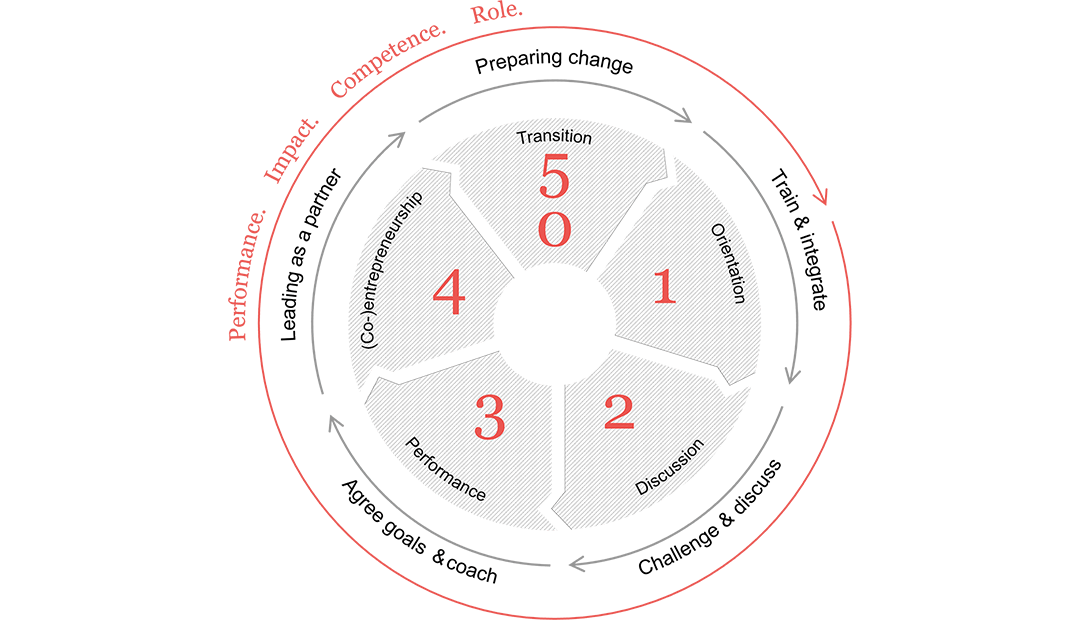Leading as a Development Partner
-
How is each individual employee's development driven and supported in my organisation?
-
Who are the sparring partners of those who want to continue their development?
-
Do we have a comprehensive picture of employees with potential, top performers, or high potentials?
-
How is performance evaluated - and how do my leaders challenge and encourage those who want to contribute in ways that go “the extra mile”?
It is the job of managers to collaborate with employees to achieve the best possible performance and to meet targets. It is equally their responsibility to support employees in their development. If these two aspects go hand in hand, leaders trigger a self-reinforcing evolution of performance and impact, skills, and understanding of roles - including their own. As a result, it becomes possible to advance people and the organisation at the same time. This requires a leadership focus tailored to the needs of the employees during the various stages of their development. After all, it is ultimately the employees who make the difference.
The value of a company essentially evolves from the growth of its team members - from their interest in their own duties, their willingness to learn, their willingness to develop, and the ways in which this is converted into benefits for the customer. Each and every one of them has the potential to advance the company and work together to build on its success.
When organisations succeed in simultaneously maintaining a culture of open learning and development as well as a culture of performance, and when they establish not only clear performance zones but also signposted learning zones - i.e., room for trying things out, learning and training - they are in a better position than others to harness this potential for the benefit of performance. Workplaces where people who think outside the box and go the extra mile are in the minority - or are even perceived as disruptive - are in danger of losing the very people who have the most potential.

Graphic: Learning and Performing Zones by Eduardo Brinceno
5P Model – Leading as a Development Partner
The 5P model of leadership as a development partnership helps executives, along with HR, to maintain a focus on the progress and growth of employees.
A deliberate look at one's own development cycle in one's own role as well as that of the individual employees helps managers to adopt a proactive approach to the individual phases of employee development and to leading them.
This is the only way to ensure that day-to-day management activities are always conducive to meeting the requirements. The 5P model of development partnership transforms the leadership relationship into a shared path upon which nuanced leadership work can and should be rendered as a service to support the development of each individual at typical stages or phases. Evaluation of performance and promotion become systemised and therefore a transparent process for managers and employees as well as a basis for exchange and mutual sparring is created.
At the very core of this process is the development of employees in terms of performance, contribution, competence, and role. The journey of development partnership offers a clear path along defined phases and thereby facilitates management work that is consciously tailored to requirements to allow individual development of employees as sparring partners in the name of the organisation.
The journey through 5 stages of employee development within a position

Applied Development Partnership
1. Orientation
New employees move cautiously in their new environment, or at least not yet with a clear understanding of their exact role and responsibilities. They depend heavily on information to better understand how things work. In this case, the main responsibility of leadership is to integrate the employees professionally and socially and to help them to quickly become fit for work and independent. This orientation phase can also involve the manager him-/herself, if, for example, he or she is starting out in a management position in a new company.
2. Confrontation
Provided that the first phase has been successfully negotiated, the new employees will have gained confidence and have become familiar with their working environment, so that their initial reserve will progressively fade, and they become more vocal about their view on things. Implicit norms of cooperation that have developed over time in a team are now more frequently infringed upon since new employees either ignore or question them. Differences of opinion and conflicts should be used by the manager as an opportunity to resolve issues comprehensively. In this phase, it is important for both sides to recognise the current level of competence and performance and to understand and negotiate each other's expectations.
3. Performance
This can kick in when a joint understanding of performance expectations and cooperation has been established and when there are no open or hidden conflicts over them. A sufficient degree of candor has evolved to allow issues to be addressed without escalating into conflict. Now this new level of collaboration facilitates an increasing focus on self-directed performance. The role of the manager is to support the employees in this phase by jointly agreeing on targets and by coaching them.
4. Collaborative Entrepreneurship
As employees progress to the fourth phase, they not only demonstrate that they can perform their duties well, but also that they have the competence and the willingness to contribute to the company beyond the scope of their assigned responsibilities. This phase cannot and need not necessarily be reached by all employees. In most cases, it is those who have a particular interest in the overall context - and in development: both their own and that of the organisation. Leadership in this phase is characterised by facilitating this and driving it forward together. Leadership responsibility in this phase focuses strongly on harnessing the interests of employees for the benefit of the company - and to involve them in decision-making and leadership roles.
5. Transition
Employees assume new responsibilities, leave a position, a team or even the organisation to pursue further development elsewhere. This phase may follow any other one as well. In this phase, the transition is prepared, both in terms of succession and knowledge management and, if applicable, severance management. As new employees join the organisation, the cycle begins anew, once again with phases that vary from person to person.
Application
Training for leaders:
During training sessions, managers can benefit from various experiences and perspectives through intensive dialog.
- In addition to fundamental input regarding the model and the various phases and requirements, participants initially reflect on their own personal experience as employees and based on their own experience, can then classify the employees they lead and define their requirements in a way that is appropriate to the respective phase
- Appropriate exercises and methodologies for phase-appropriate communication help managers to optimise their development partnership with their employees
Reflection tool in coaching:
The model offers a sound basis for reflecting on your own team and for appropriately guiding the team members based on their respective phases of development.
Workshops for leadership teams:
The concept of "Leadership as Development Partner" can be implemented together in leadership team workshops within the organisation to develop a common perspective and to systematically categorise and discuss employees and their development potential.
